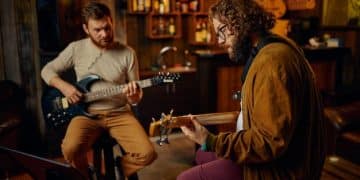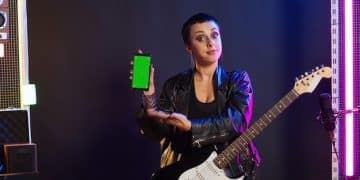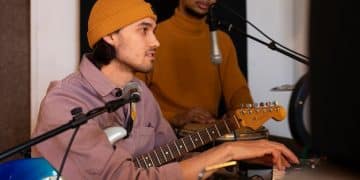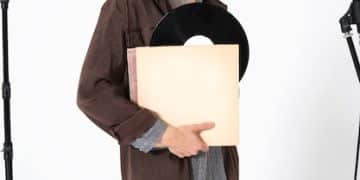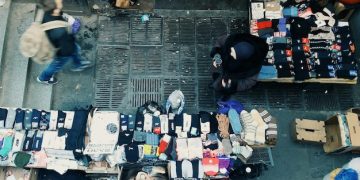Emerging Artists’ Guide to US Copyright Law in the Digital Age
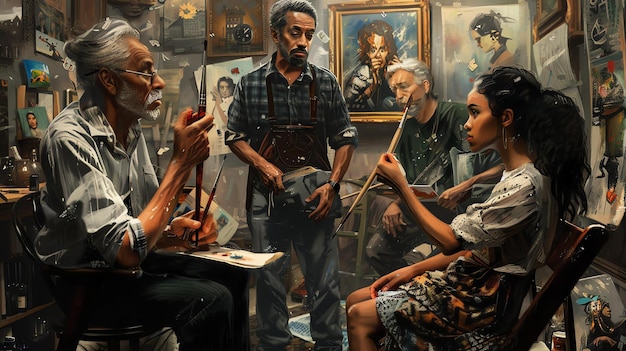
Navigating US copyright law in the digital age is crucial for emerging artists to protect their creative works, ensuring legal ownership and controlling unauthorized use of their intellectual property.
In the expansive and often bewildering landscape of the digital realm, emerging artists face a unique set of challenges and opportunities. Protecting one’s creative output from unauthorized use has never been more critical. This comprehensive emerging artists’ guide to navigating US copyright law in the digital age aims to demystify complex legal concepts, empowering creatives to safeguard their intellectual property and thrive in a continuously evolving artistic ecosystem.
Understanding the Foundation: What is Copyright?
Copyright, at its core, is a legal right granted to creators for their original works of authorship. It encompasses literary, dramatic, musical, and artistic works, including poetry, novels, movies, songs, computer software, and architecture. Essentially, once you create an original work and fix it in a tangible medium, copyright automatically vests in you, the creator. This automatic protection, however, has limitations, especially when considering enforcement and the digital landscape.
The concept of “originality” is key here. It doesn’t necessarily mean groundbreaking or unique, but simply that the work originated from you, not copied from someone else. The “tangible medium” requirement means it must be something perceivable—written down, recorded, painted, or saved digitally. This automatic protection grants a bundle of exclusive rights, which form the bedrock of an artist’s ability to control their creations.
The Bundle of Rights: What You Own
Understanding the specific rights associated with copyright is essential for any emerging artist. These exclusive rights empower creators to control how their work is used and disseminated. Without a clear grasp of these, artists might inadvertently waive significant protections or fail to monetize their creations effectively.
- Reproduction Right: The ability to make copies of the copyrighted work. This is fundamental in the digital age, where copying is often just a click away.
- Distribution Right: The right to sell, rent, lease, or otherwise transfer ownership of copies of the copyrighted work. Think about digital downloads or physical albums.
- Public Performance Right: The right to perform the copyrighted work publicly. This applies to music, literary works, and dramatic works, covering everything from concert halls to streaming platforms.
- Public Display Right: The right to display the copyrighted work publicly. Visual artists, for instance, exercise this right when exhibiting their paintings or photographs.
- Derivative Works Right: The right to prepare derivative works based upon the copyrighted work. This means transforming, adapting, or building upon an existing work, like turning a novel into a film.
These rights collectively provide a robust framework for creators to manage their intellectual property. However, the digital landscape introduces complexities that necessitate a deeper understanding of how these rights apply in an online context.
For instance, merely posting a song on a social media platform might imply a license for that platform to use it within its terms, potentially affecting your exclusive rights. Therefore, carefully reviewing terms of service is paramount before uploading any creative work online. Navigating these nuances is vital for new artists aiming to build sustainable careers while protecting their valuable contributions.
Registration: The Power Play in Copyright Protection
While copyright automatically vests upon creation, registration with the U.S. Copyright Office is not merely an optional formality; it’s a strategic imperative for emerging artists. Federal registration provides significant legal advantages, making it a critical step for serious creators looking to protect their work effectively.
Without registration, an artist’s ability to enforce their rights in court is severely limited. You cannot sue for copyright infringement in federal court unless your work is registered. This alone should underscore its importance. Beyond litigation, registration offers a clear, public record of your claim, deterring potential infringers and simplifying disputes.
Benefits of Registration: Beyond Basic Protection
The advantages of copyright registration extend far beyond merely establishing ownership. They provide powerful tools for enforcement and financial recovery in the event of infringement. Understanding these benefits can motivate artists to take this crucial administrative step, despite the perceived hassle.
- Public Record of Ownership: Registration creates a public record of your copyright claim, which can deter potential infringers. It serves as official acknowledgment of your ownership, making it harder for others to claim ignorance.
- Ability to Sue for Infringement: As mentioned, you must register your work before you can file a lawsuit for copyright infringement in federal court. This is a non-negotiable prerequisite for legal action.
- Statutory Damages and Attorney’s Fees: This is perhaps the most compelling reason to register. If your work is registered prior to the infringement, you may be entitled to statutory damages and attorney’s fees. This means you don’t have to prove actual monetary losses, and the court can award a set amount (between $750 and $30,000 per infringement, up to $150,000 for willful infringement) plus cover your legal costs. Without registration, you can only recover actual damages, which are often difficult and expensive to prove.
- Prima Facie Evidence: A certificate of registration obtained within five years of publication of the work serves as “prima facie” evidence in court that the copyright is valid and that the facts stated in the certificate are true. This shifts the burden of proof, making your case significantly stronger.
The registration process, while requiring attention to detail, is straightforward when following the U.S. Copyright Office guidelines. It involves completing an application form, paying a fee, and submitting a copy of your work. The office provides clear instructions and an online system to facilitate this process. For works created collaboratively or in series, understanding the different types of applications (e.g., single application for a group of published works) can save time and money.
For works distributed digitally, ensuring a proper deposit copy is submitted is crucial. This often means providing the work in a commonly accessible digital format. Artists should also consider the timing of their registration; registering promptly after creation or before significant public distribution maximizes the available statutory damages in case of early infringement.
Copyright in the Digital Age: Challenges and Opportunities
The internet has revolutionized how art is created, shared, and consumed. While it offers unprecedented opportunities for exposure and connection, it also presents significant challenges for copyright protection. The ease of copying, sharing, and manipulating digital content means that infringements can be widespread and difficult to track.
Emerging artists must be acutely aware of these dynamics. Platforms like YouTube, Instagram, Spotify, and TikTok operate under complex legal frameworks, including aspects of copyright law. Understanding how these platforms handle user-generated content, licensing, and takedown notices is paramount for maintaining control over your work.
Understanding Fair Use and Public Domain
Not every use of copyrighted material constitutes infringement. Two significant exceptions that often arise in the digital space are “fair use” and works in the “public domain.” A clear understanding of these concepts prevents both unintentional infringement and missed opportunities.
- Fair Use: This doctrine permits limited use of copyrighted material without permission for purposes such as criticism, comment, news reporting, teaching, scholarship, or research. It’s determined by a four-factor test:
- The purpose and character of the use (e.g., commercial vs. nonprofit educational).
- The nature of the copyrighted work.
- The amount and substantiality of the portion used in relation to the copyrighted work as a whole.
- The effect of the use upon the potential market for or value of the copyrighted work.
Fair use is a highly contextual and often litigated area. Artists should not assume their use falls under fair use without careful consideration or legal advice.
- Public Domain: Works in the public domain are no longer protected by intellectual property law and belong to the public. They can be used by anyone for any purpose without permission or payment. Works enter the public domain when their copyright expires (generally 70 years after the author’s death in the US), when they were never copyrighted, or when copyright was forfeited. Works created by the U.S. government are also typically in the public domain. Leveraging public domain works can be a great way for artists to build upon existing foundations without legal repercussions.
The digital age has also amplified discussions around transformative use, a key aspect of the fair use defense. If a new work sufficiently transforms the original, giving it a new meaning or message, it is more likely to be considered fair use. This encourages creative expression and cultural discourse, but the line between adaptation and infringement can be thin.
The prevalence of user-generated content on platforms means artists may encounter their work being used by others. Conversely, artists may wish to use snippets or inspirations from other works. Understanding the fair use doctrine is crucial for both defending against infringement claims and for responsibly integrating existing cultural elements into new creations. Ignorance of these boundaries can lead to costly legal battles.
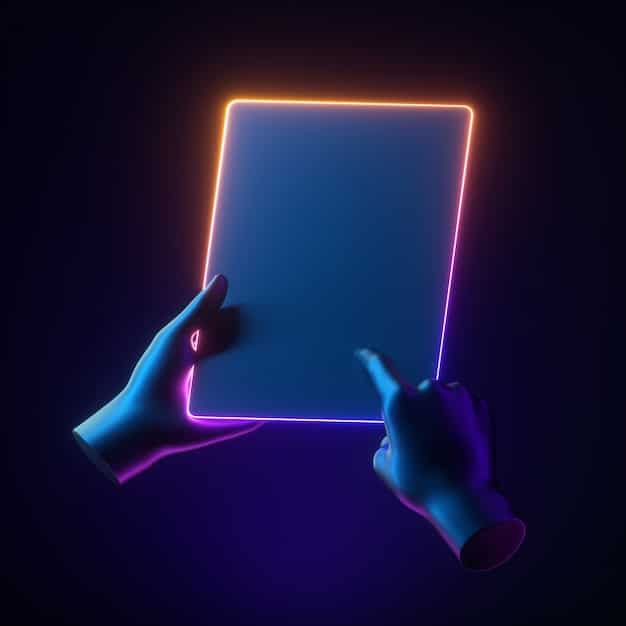
Licensing and Permissions: Monetizing and Collaborating
For many emerging artists, copyright isn’t just about protection; it’s also about opportunity. Licensing your work allows others to use your copyrighted material under specific terms, typically in exchange for a fee. This is a primary method for artists to monetize their creations and expand their reach.
Permissions, on the other hand, are grants of rights for a one-time or specific use without necessarily involving a complex licensing agreement. Both are crucial for collaborations and maximizing the value of your intellectual property.
Types of Licenses and Agreements
Understanding the different types of licenses is vital for artists entering into agreements. The terms of a license dictate how, where, and for how long your work can be used. Poorly negotiated licenses can lead to loss of control, undervaluation of your work, or inadvertent waiver of essential rights.
- Exclusive vs. Non-Exclusive: An exclusive license grants rights solely to the licensee, meaning even the copyright holder cannot use the work in that specified way. A non-exclusive license allows the copyright holder to grant the same rights to multiple parties. For many artists, non-exclusive licenses offer more flexibility for revenue generation.
- Perpetual vs. Term-Limited: Perpetual licenses last forever, while term-limited licenses expire after a certain period, requiring renegotiation or renewal. Artists should generally prefer term-limited licenses, especially for growing works.
- Territory Restrictions: Licenses can specify geographic areas where the work may be used (e.g., North America, worldwide).
- Usage Restrictions: This defines how the work can be used (e.g., for print only, for digital advertising, for merchandising).
- Royalty-Based vs. Flat Fee: Royalty-based licenses involve ongoing payments based on usage or sales figures. Flat-fee licenses involve a one-time payment. A combination of both is often desirable.
Beyond traditional licensing, the digital age has given rise to new models. Creative Commons licenses, for example, offer a standardized way for creators to grant public permission to use their work under specific conditions, without requiring individual negotiation. These can be particularly useful for artists who want their work to be widely shared and built upon, but still with certain safeguards.
When entering any licensing agreement, artists should seek clarity on all terms. This includes compensation, scope of use, duration, and termination clauses. It’s often advisable to have an attorney review significant licensing agreements, especially for works with high commercial value. Online platforms often have their own default licensing terms within their user agreements, which artists should read carefully before uploading content.
Combating Infringement: Your Rights and Actions
Despite best efforts at prevention and education, copyright infringement remains a persistent issue in the digital age. When your work is used without permission, knowing your legal recourse and how to act swiftly is crucial. Proactive monitoring and a clear strategy for enforcement can mitigate damages and protect your creative assets.
The first step in combating infringement is often a “cease and desist” letter, formally notifying the infringer of your rights and demanding they stop the unauthorized use. This can often resolve disputes without costly litigation. However, if the infringement continues, or if significant damages have occurred, further legal action may be necessary.
Digital Millennium Copyright Act (DMCA) and Takedowns
The Digital Millennium Copyright Act (DMCA), enacted in 1998, provides a key mechanism for copyright holders to address online infringement. It’s especially relevant for emerging artists whose work is often shared or hosted on third-party platforms. The DMCA includes provisions that protect online service providers (OSPs) from liability for copyright infringement committed by their users, provided they comply with certain requirements, including having a designated agent to receive takedown notices.
- DMCA Takedown Notice: This is a formal request sent to an OSP (like YouTube, Facebook, or your web host) to remove infringing material. For the notice to be valid, it typically must include:
- A physical or electronic signature of the copyright owner or a person authorized to act on their behalf.
- Identification of the copyrighted work claimed to have been infringed.
- Identification of the infringing material and information reasonably sufficient to permit the OSP to locate the material.
- Information reasonably sufficient to permit the OSP to contact the complaining party (address, telephone number, email address).
- A statement that the complaining party has a good faith belief that use of the material in the manner complained of is not authorized by the copyright owner, its agent, or the law.
- A statement that the information in the notification is accurate, and under penalty of perjury, that the complaining party is authorized to act on behalf of the owner of an exclusive right that is allegedly infringed.
- Counter-Notification: If a user believes their content was removed by mistake or misidentification (e.g., it was fair use, or they had a license), they can submit a counter-notification. This can lead to the material being reinstated unless the copyright owner files a court action.
The DMCA takedown process is often the quickest and most cost-effective way for artists to remove infringing content from the internet. Many platforms have automated systems for submitting these notices, making the process accessible even for those without extensive legal knowledge. However, proper identification of the infringing material and precise adherence to the notice requirements are critical for successful takedowns.
While DMCA notices are powerful, they don’t preclude other legal actions. If a pattern of infringement continues or if a specific infringer is causing substantial damage, an artist may still consider pursuing a lawsuit for damages. Legal counsel becomes increasingly important at this stage, especially when navigating federal court procedures and complex damage calculations. Documenting every instance of infringement, including screenshots, dates, and URLs, is invaluable evidence for any future legal action.
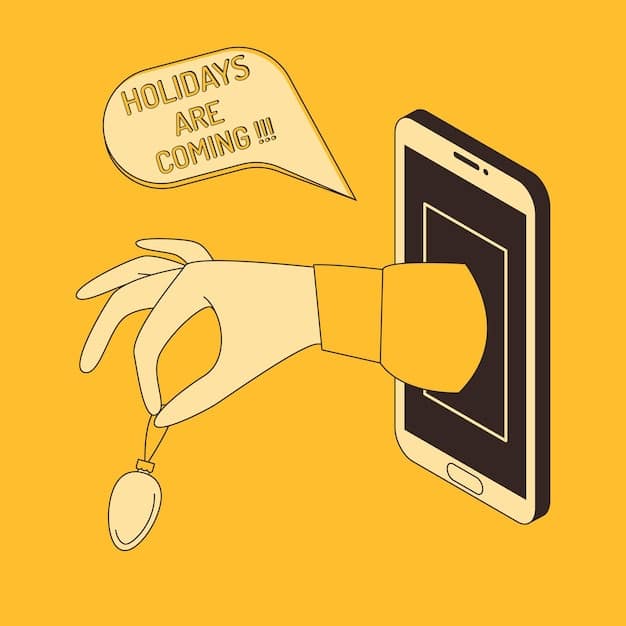
Best Practices for Emerging Artists in the Digital Age
Beyond understanding the legal intricacies, emerging artists can adopt practical strategies to protect their work and foster a secure creative environment. These best practices are not just about compliance; they are about empowerment, enabling artists to focus on their craft with peace of mind.
Proactive measures are often more effective and less costly than reactive legal battles. Integrating copyright considerations into your creative workflow from the very beginning can save significant headaches down the line.
Protecting Your Work from Day One
From the moment of creation, there are immediate steps artists can take to secure their intellectual property. These habits can significantly strengthen your position should a dispute ever arise.
- Keep Meticulous Records: Document every step of your creative process. This includes dates, drafts, notes, and communications related to your work. This paper trail can be invaluable evidence to prove ownership and the date of creation.
- Use Copyright Notices: While not legally required for protection, placing a copyright notice (e.g., “© [Year of creation] [Your Name/Company]. All Rights Reserved.”) on your work is a clear signal to others that you claim copyright. It can deter casual infringers.
- Register Early and Often: As discussed, timely registration with the U.S. Copyright Office is crucial for statutory damages and attorney’s fees. Register your work as soon as it’s completed or before significant public distribution.
- Control Your Digital Footprint: Be mindful of where and how you upload your work online. Review the terms of service of any platform you use, as they may include clauses about licensing or ownership. Consider using watermarks or lower-resolution versions for online previews.
- Educate Yourself Continuously: Copyright law is dynamic, especially in the digital age. Stay informed about changes in laws, court decisions, and platform policies. Resources from the U.S. Copyright Office, legal blogs, and artist advocacy groups can be incredibly helpful.
Networking with other artists and legal professionals can also provide invaluable insights and support. Sharing experiences and learning from others’ challenges can enhance your own protective strategies. Consider joining artist organizations that offer legal resources or workshops. The digital landscape demands constant vigilance and adaptability, but with the right knowledge and habits, emerging artists can navigate these waters successfully, ensuring their creative legacies are protected for years to come.
Furthermore, understanding the nuances of contracts and agreements is increasingly important. Whether it’s a commission, a gallery exhibition, or a collaboration, ensure all terms are clear, documented, and reflect your intentions regarding copyright. Never rely solely on verbal agreements when intellectual property is involved.
The Future of Copyright for Emerging Artists
The legal landscape surrounding copyright is constantly evolving, particularly with the rapid advancements in artificial intelligence (AI) and blockchain technology. Emerging artists need to remain adaptive and informed to leverage new tools while protecting their rights against novel forms of infringement.
AI-generated content, for instance, raises complex questions about authorship and originality: who owns the copyright to a work created by an AI, or a work that extensively uses AI tools? Similarly, blockchain technology offers potential solutions for immutable proof of ownership and transparent rights management, but its legal interoperability is still being defined.
AI, NFTs, and Emerging Legal Frontiers
These burgeoning technologies are creating new opportunities and new challenges for copyright law. Artists who understand these shifts will be better positioned to adapt and thrive.
- Artificial Intelligence (AI) and Copyright:
The rise of generative AI models (e.g., DALL-E, ChatGPT, Midjourney) introduces significant complexities. Questions include:
- Does an AI-generated work meet the “human authorship” requirement for copyright protection? The U.S. Copyright Office currently maintains human authorship is necessary.
- Is the unconsented use of copyrighted works to train AI models an infringement? This is a highly litigated area with no definitive answer yet.
- Who owns the copyright to a work created by an artist using AI tools—the artist, the AI developer, or neither?
Emerging artists need to be aware of these debates and how they might impact their own practices, both as creators and as potential victims of AI-related infringement.
- Non-Fungible Tokens (NFTs) and Ownership:
NFTs offer a digital certificate of ownership for digital assets, but they do not inherently transfer copyright. Owning an NFT means you own a unique token linked to a digital file, not necessarily the underlying intellectual property. Artists selling NFTs must clearly define what rights are being transferred to the buyer—is it just ownership of the token, or a limited license to display, or full copyright?
Conversely, artists purchasing NFTs should understand what copyright rights they are gaining, if any. The burgeoning NFT market has seen numerous instances of artists having their work “minted” as NFTs without their permission, leading to new forms of infringement that require novel enforcement strategies.
- Blockchain and Rights Management:
Blockchain technology has the potential to create transparent and immutable records of creation and ownership, potentially streamlining rights management and royalty distribution. While still in early stages for copyright, its adoption could offer more robust tracking of copyrighted material across the digital sphere.
Staying informed about legislative developments, landmark court cases, and industry standards related to these emerging technologies is crucial. Attending webinars, following reputable legal tech journals, and consulting with legal professionals who specialize in intellectual property and new technologies can keep emerging artists at the forefront of these discussions. The future of copyright is being shaped now, and active participation and informed decision-making will empower artists to navigate these new frontiers successfully.
Adapting to these changes means not just reacting to problems but also exploring how these technologies can be harnessed for enhanced protection and new revenue streams. The digital age continues to redefine the artistic ecosystem, and understanding its legal underpinnings is more vital than ever for the next generation of creators.
| Key Point | Brief Description |
|---|---|
| 💡 Auto-Protection | Copyright automatically applies upon creation in a tangible form. |
| 📑 Registration is Key | Federal registration enables lawsuits & statutory damages. |
| 🔗 Digital Challenges | Ease of copying online necessitates DMCA awareness. |
| 🔮 Future Trends | AI & NFTs bring new complexities and opportunities. |
Frequently Asked Questions About Copyright for Artists
▼
No, copyright protection is automatic the moment your original work is fixed in a tangible form. However, registering your copyright with the U.S. Copyright Office is highly recommended. It grants you significant legal advantages, such as the ability to sue for infringement in federal court and potentially collect statutory damages and attorney’s fees.
▼
Fair use is a legal doctrine that permits limited use of copyrighted material without permission for purposes like criticism, commentary, news reporting, teaching, scholarship, or research. It’s determined by a four-factor test focusing on the purpose, nature, amount used, and market effect. Artists often inquire about fair use when incorporating existing elements into new works, but it’s a complex area and not an automatic right.
▼
Digitally, you can include copyright notices, use watermarks, or upload lower-resolution versions for previews. More importantly, register your work with the U.S. Copyright Office. If infringement occurs, utilize DMCA takedown notices to get infringing content removed from websites and platforms. Consistent monitoring of your online presence for unauthorized use is also a good practice.
▼
An NFT (Non-Fungible Token) is a digital certificate confirming unique ownership of a digital asset, like a piece of art, on a blockchain. It does not inherently transfer copyright. Copyright is the legal right to control how your art is used, reproduced, and distributed. When selling an NFT, artists must specify what, if any, copyright licenses or rights are bundled with the NFT purchase; otherwise, the buyer only owns the token.
▼
Creative Commons licenses provide a standardized way for creators to grant permission for certain uses of their work directly to the public, without requiring individual negotiations. They can be beneficial if your goal is to encourage sharing, remixing, or broader dissemination of your art, while still retaining some control and attribution. Decide based on your specific creative and commercial goals.
Conclusion
For emerging artists navigating the complex, dynamic landscape of the digital age, understanding and strategically applying US copyright law is not merely a legal detail but a fundamental pillar of a sustainable creative career. From the automatic protection granted upon creation to the considerable advantages of federal registration, each step taken to safeguard intellectual property empowers artists to control their narratives, monetize their efforts, and challenge unauthorized uses. By embracing best practices, staying informed about evolving technologies like AI and NFTs, and recognizing the power of their exclusive rights, artists can confidently share their unique visions with the world, assured that their creative ownership remains intact.
